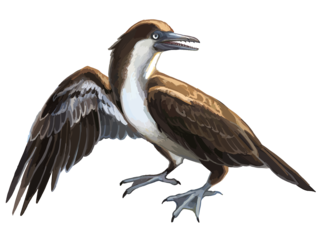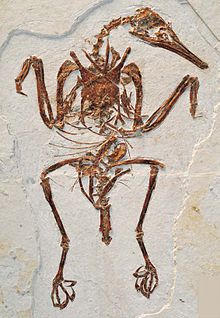
The Enantiornithes, also known as enantiornithines or enantiornitheans in literature, are a group of extinct avialans, the most abundant and diverse group known from the Mesozoic era. Almost all retained teeth and clawed fingers on each wing, but otherwise looked much like modern birds externally. Over eighty species of Enantiornithes have been named, but some names represent only single bones, so it is likely that not all are valid. The Enantiornithes became extinct at the Cretaceous–Paleogene boundary, along with Hesperornithes and all other non-avian dinosaurs.

Yanornis is an extinct genus of fish-eating Early Cretaceous birds. Two species have been described, both from Liaoning province, China: Yanornis martini, based on several fossils found in the 120-million-year-old Jiufotang Formation at Chaoyang, and Yanornis guozhangi, from the 124-million-year-old Yixian Formation.

Liaoningosaurus is an unusual genus of basal ankylosaurid dinosaur from the Liaoning Province, China that lived during the Early Cretaceous in what is now the Yixian and Jiufotang Formation. The type and only species, Liaoningosaurus paradoxus, is known from more than 20 specimens, with some representing juveniles. It was named in 2001 by Xu, Wang and You.

Longipteryx is a genus of prehistoric bird which lived during the Early Cretaceous. It contains a single species, Longipteryx chaoyangensis. Its remains have been recovered from the Jiufotang Formation at Chaoyang in Liaoning Province, China. Apart from the holotype IVPP V 12325 - a fine and nearly complete skeleton — another entire skeleton and some isolated bones are known to date.

Longirostravis is a genus of enantiornithean birds which existed during the early Cretaceous period and is known from fossils found in the middle or upper Yixian Formation in Yixian County, People's Republic of China. It is known from a single specimen housed in the collections of the Institute of Vertebrate Paleontology and Paleoanthropology representing the type species Longirostravis hani.

Yixianornis is a bird genus from the early Cretaceous period. Its remains have been found in the Jiufotang Formation at Chaoyang dated to the early Aptian age, around 120 million years ago. Only one species, Yixianornis grabaui, is known at present. The specific name, grabaui, is named after American paleontologist Amadeus William Grabau, who surveyed China in the early 20th century.
The Jiufotang Formation is an Early Cretaceous geological formation in Chaoyang, Liaoning which has yielded fossils of feathered dinosaurs, primitive birds, pterosaurs, and other organisms. It is a member of the Jehol group. The exact age of the Jiufotang has been debated for years, with estimates ranging from the Late Jurassic to the Early Cretaceous. New uranium-lead dates reveal the formation is deposited in the Aptian stage of the Early Cretaceous. Fossils of Microraptor and Jeholornis are from the Jiufotang.
Pengornis is the largest known enantiornithine bird from the Early Cretaceous of northeast China. The name derives from "Peng", which refers to a mythological bird from Chinese folklore, and "-ornis", which means bird in Greek.

Shanweiniao is a genus of long-snouted enantiornithean birds from Early Cretaceous China. One species is known, Shanweiniao cooperorum. There is one known fossil, a slab and counterslab. The fossil is in the collection of the Dalian Natural History Museum, and has accession number DNHM D1878/1 and DNHM1878/2. It was collected from the Lower Cretaceous Dawangzhengzi Beds, middle Yixian Formation, from Lingyuan in the Liaoning Province, China.
Huoshanornis is a genus of enantiornithine birds which existed in what is now Jiufotang Formation of Western Liaoning Province, China during the early Cretaceous period. Its fossil remains were found at Chaoyang City. It was first named by Xia Wang, Zihui Zhang, Chunling Gao, Lianhai Hou, Qingjin Meng and Jinyuan Liu in 2010 and the type species is Huoshanornis huji.

Longipterygidae is a family of early enantiornithean avialans from the Early Cretaceous epoch of China. All known specimens come from the Jiufotang Formation and Yixian Formation, dating to the early Aptian age, 125-120 million years ago.

Bohaiornis is a genus of enantiornithean birds. Fossils have been found from the Lower Cretaceous Jiufotang Formation of western Liaoning, China. The only known species, Bohaiornis guoi, was named by Dongyu Hu, Li Li, Lianhaim Hou and Xing Xu in 2011 on the basis of a fully articulated and well-preserved skeleton of a sub-adult. This specimen, LPM B00167, preserved two long, ribbon-like feathers attached to the tail rather than a fan of shorter pennaceous feathers. It was similar to the slightly older Eoenantiornis, but much larger in size. Bohaiornis is the type species of Bohaiornithidae, a family of large predatory enantiornitheans from the Early Cretaceous.
Camptodontornis is an extinct genus of enantiornithine bird which existed in what is now Chaoyang in Liaoning Province, China during the early Cretaceous period. It is known from a well-preserved skeleton including a skull found in the Jiufotang Formation of Liaoning Province. Its original generic name was "Camptodontus" ; it was named by Li Li, En-pu Gong, Li-dong Zhang, Ya-jun Yang and Lian-hai Hou in 2010. However, the name had previously been used for a genus of beetle. The type species is "Camptodontus" yangi. Demirjian (2019) coined a replacement generic name Camptodontornis. The status of C. yangi as a distinct species is disputed, with Wang et al. (2015) considering it to be a probable synonym of Longipteryx chaoyangensis.
Gracilornis is an extinct genus of early bird from the lower Cretaceous. It is a cathayornithid enantiornithine which lived in what is now western Liaoning Province, China. It is known from a nearly complete skull and postcranial skeleton, which was found from the Jiufotang Formation, in Chaoyang. It was first named by Li Li and Hou Shilin in 2011 and the type species is Gracilornis jiufotangensis. The generic name is derived from Latin gracilis, "slender" and Greek ornis, "bird", and refers to its slender skeleton. The specific name was named after the Jiufotang Formation, in which the holotype was collected.
Parabohaiornis is an extinct genus of bohaiornithid enantiornithean dinosaur known from the Early Cretaceous of Liaoning Province, northeastern China. It contains a single species, Parabohaiornis martini.

Chuanqilong is a monospecific genus of basal ankylosaurid dinosaur from the Liaoning Province, China that lived during the Early Cretaceous in what is now the Jiufotang Formation. The type and only species, Chuanqilong chaoyangensis, is known from a nearly complete skeleton with a skull of a juvenile individual. It was described in 2014 by Fenglu Han, Wenjie Zheng, Dongyu Hu, Xing Xu, and Paul M. Barrett. Chuanqilong shows many similarities with Liaoningosaurus and may represent a later ontogenetic stage of the taxon.

Pengornithidae is a group of early enantiornithines from the early Cretaceous Period of China, with the putative member Falcatakely possibly extending this clade's range into the Late Cretaceous of Madagascar, and several putative pengornithids also hail from this formation. Specimens of these animals have been found both in the Huajiying Formation and Jiufotang Formation of Liaoning and Hebei provinces, dating from the Hauterivian age to the Aptian age.

Forfexopterus is a genus of ctenochasmatid pterosaur from the Early Cretaceous Jiufotang Formation in China. It contains a single species, F. jeholensis, named from a mostly complete skeleton by Shunxing Jiang and colleagues in 2016. A second specimen, consisting of a wing, was described in 2020. While the first specimen is larger, it shows signs of being less mature than the second specimen, indicating that the developmental trajectories of Forfexopterus were variable. Like other ctenochasmatids, Forfexopterus had a long, low skull filled with many slender teeth; unlike other members of the group, however, it did not have a spatula-shaped snout tip or crests, and its teeth were more curved. A single characteristic distinguishes Forfexopterus from all other members of the wider group Archaeopterodactyloidea: of the four phalanx bones in its wing finger, the first was shorter than the second but longer than the third.
Musivavis is a genus of euenantiornithine bird from the Early Cretaceous (Aptian) Jiufotang Formation of Liaoning Province, China. The genus contains a single species, Musivavis amabilis, known from a nearly complete, articulated skeleton.















